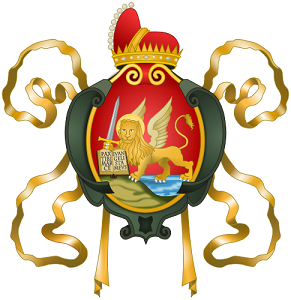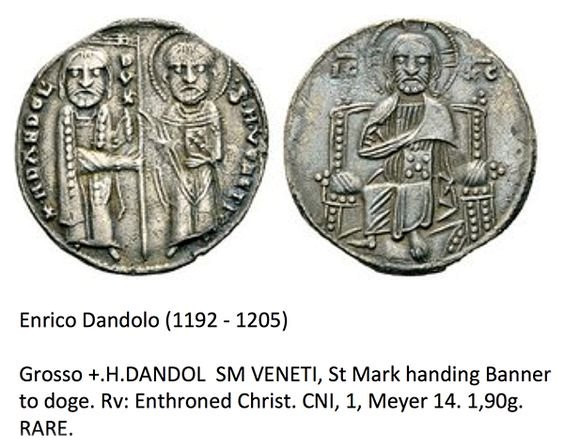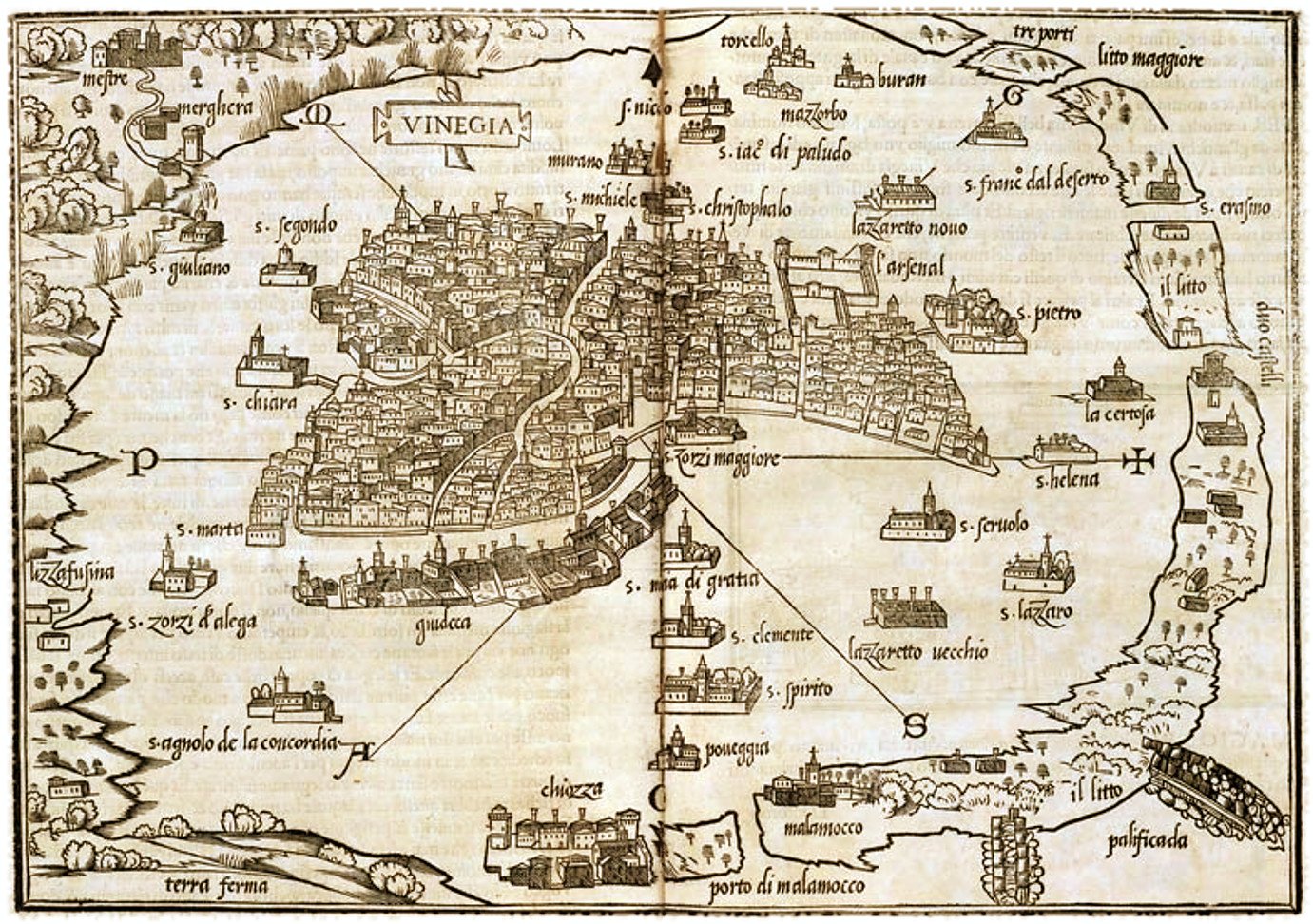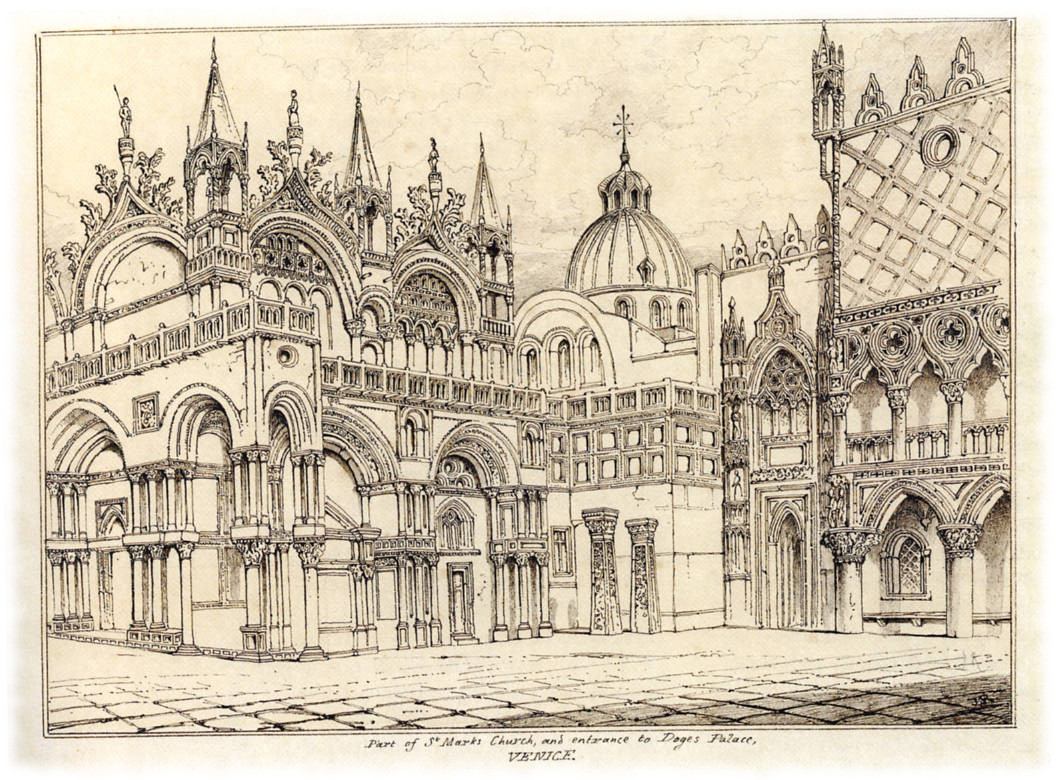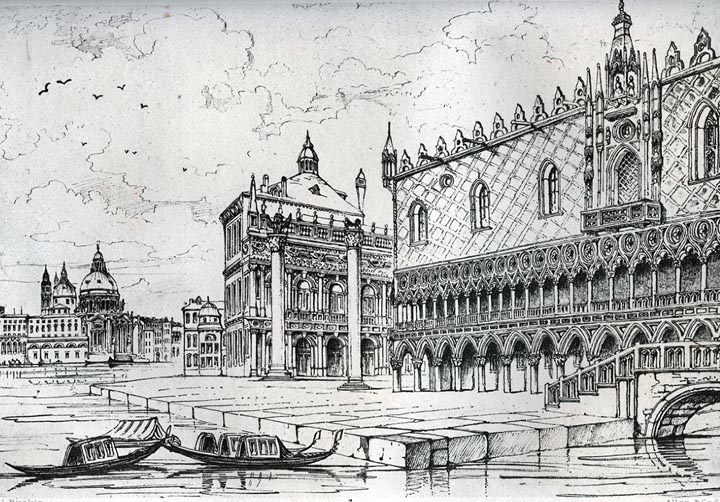Difference between revisions of "Venice -- medieval"
(→Storia) |
|||
| Line 93: | Line 93: | ||
---- | ---- | ||
== '''Storia''' == | == '''Storia''' == | ||
| − | + | === Introduzione === | |
| − | + | The Republic of Venice (Venetian: ''Repùblica Vèneta''; Italian: ''Repubblica di Venezia''), traditionally known as the Most Serene Republic of Venice (Venetian: ''Serenìsima Repùblica Vèneta''; Italian: ''Serenissima Repubblica di Venezia''), was a sovereign state and maritime republic in northeastern Italy, which existed for a millennium between the 8th century and the 18th century. It was based in the lagoon communities of the historically prosperous city of Venice, and was a leading European economic and trading power during the Middle Ages and the Renaissance. | |
| − | + | ||
| − | + | === Umili Origini === | |
| − | + | The history of the Republic of Venice traditionally begins with its foundation at noon on Friday 25 March AD 421, by authorities from Padua, to establish a trading-post in that region of northern Italy; the founding of the Venetian republic also was marked with the founding of the church of St. James. The early city of Venice existed as a collection of lagoon communities who united for mutual defense against the Lombards, as the power of the Byzantine Empire dwindled in northern Italy in the late 7th century. | |
| − | === | + | |
| + | Early in the 8th century, the people of the lagoon elected their first leader Orso Ipato (Ursus), who was confirmed by Byzantium with the titles of ''hypatus'' and ''dux''. Historically, Ursus was the first Doge of Venice. Tradition, however, since the early 11th century, dictates that the Venetians first proclaimed one Paolo Lucio Anafesto (Anafestus Paulicius) duke in AD 697, although the tradition dates only from the chronicle of John, deacon of Venice (John the Deacon); nonetheless, the power base of the first doges was in Eraclea. | ||
---- | ---- | ||
<br> | <br> | ||
Revision as of 13:14, 23 April 2018
Contents
Il Proemio
Called "the Most Serene Commune of Venice" (or La Serenissima), Venice is the second-largest city in Italy, with upwards of 120,000 inhabitants. It is also a hotbed of Cainite intrigue. Catholic Lasombra struggle with their heretical brethren, and the bustling port brings Cainites from across the Mediterranean, all under the watchful eyes of Narses, Prince of Venice and Archbishop of Nod. Therefore, Venice is in the unique position of being a crossroads used by Cainite and kine alike. It is a neutral meeting ground where East meets West and anything can be purchased for a price. Those new to the city may find Venice unsettling, even disturbing.
Aspetto
Clima
Venice has a Humid subtropical climate, with cool winters and very warm summers. Precipitation is spread relatively evenly throughout the year, and averages 29.4 in.
Dispositivo di Città
Economia
Preface
Venice, situated at the far end of the Adriatic Sea, gained large scale profit of the adjacent middle European markets (Eastern European). So did the fact that the town belonged to the Byzantine Empire. Along with increasing autonomy it gained far reaching privileges in both Empires. As a consequence of the Fourth Crusade, the venetian doge became - at least nominally - dominator of three-eighths of Byzantium, all trading ways opened up and a colonial empire, concentrated on the Aegean, developed.
As a consumer center Venice did play a rather meaningless role. But within a long process of adaptation and learning the Venetians developed techniques of trade, forms of companies and methods of finance, but to the same degree means of business development, of insurance and patent protection, in addition technical and organizational innovations, last not least means of controlling the money-market, that made them forerunners of developments for the rest of Europe.
Nevertheless only the nobility or patriciate had the right to exercise the wealth-bringing long-distance trade. It was the same patriciate that erected a monopoly of political leadership. It left production and small business to the strata of its society that were not capable of becoming a member of the council - which was the visible sign of nobility. On the other hand they provided protection against competitors, against violation of secrecy - and exercised strict control.
Ab initio Venice had to face fierce competition and rivalry, especially coming from Genoa. War, whether declared or not, was the normal status that for four times culminated in year-long open wars, conducted with all means. Finally, the tiny - as far as its expanse was concerned - super power had to draw back, because the world powers of those days, Spain and the Ottoman Empire, had a world of natural and human resources, Amsterdam, London and Lisbon the political and economic means that Venice could not afford in that ever growing range.
Introduction
Venice's historical roots reach at least as far back as the Etruscan Culture. The settlements from which later on Venice grew up, could revive the late Roman trade with Northern Italy. At the same time Venice succeeded in extending its privileges in the Byzantine Empire. Byzantium as well as the Holy Roman empire were always prepared to concede privileges to the Venetian traders, when they were in heavy political constraints. These far going privileges - as barbed as they were - formed the judicial basis for the preponderance of the Adriatic town in commercial matters. At the same time it reached its aims to overthrow the Dalmatian and Italian rivals and to secure the routes of transport.
The crusades brought intensification of trade, of which Venice took profit so that it soon ranked first among the trading nations. Already a century before the conquest of Constantinople (1204) lots of traders' colonies flourished. This the more, when the Venetians conquered Crete and other important points that together formed a colonial empire, the backbone of free trade and of the convoys of large ships sent to the markets around the Mediterranean sea. In addition it offered significant opportunities to regulate the local balances of power and secured partly the means of living - especially wheat - for the mother town.
Taking and keeping control of long distance trade from Venice necessitated new means and measures of checking and controlling. The "commercial revolution" with its new cultural, organizational forms, not to forget with its new ways of living, led to a never before seen predominance of economy, especially as the economically leading clans were at the same time incorporated in the vehicles of political power. Economic success attracted - as ever - thousands of people, amongst them many artisans with capabilities of utmost importance, such as the diversification of new artistic techniques and technical processes.
The Crusades and the conquest of the Byzantine capital opened a direct route to Middle-eastern and Asian markets. But these voyages, similar to the costly convoys to Flanders, Tunisia, Syria and Constantinople, required huge amounts of capital, which normally meant credit. This fact is closely combined with the early reduction of barter and a strong position of money-mediated trade. A long learning-process that lead to a rudimentary economic policy started, including patent protection, legal provisions for the opening of trade routes, and provisions to prevent the debasing of trade metals like gold.
The city of Venice could finance its everyday duties via the revenues drawn from tariffs, but in difficult times it rigidly made recourse to the estate and capital of the thousand rich families. Money at its core in those days mostly consisted of gold or silver. As a consequence, the economy depended heavily on the timely increase and decrease of these metals. So Venice had to develop a highly flexible system of currencies and exchange rates between coins consisting of silver and gold, if it wanted to preserve and enhance its role as a platform and turntable of international transaction. In addition the exchange rates between the currencies circulating within and outside of Venice had to be adjusted adequately. On the other hand the nobility had hardly any scruples to force its colonies to accept exchange rates, which were only useful for the rich.
In addition Italian traders were used to means of payment, which could help avoid the transportation of gold and silver, that were particularly expensive and dangerous. Crediting became a way to bridge the ubiquitous lack of noble metals, and at the same time, to accelerate the turnover of goods, these techniques were a primitive form of banking and the creation of letters of credit, the forerunner of paper money. Also available and helpful were to float loans, used as a kind of traders' money, circulating from hand to hand. The moneychangers played as important a role as the later state-controlled banks whose predecessors in Venice were the "wheat chamber" or Camera frumenti.
Despite the predominance of intermediary trade, ship building was an industry of utmost importance right from the beginning - and it was by far the most important employer. Quite important in the later Middle Ages were the production of draperies, silk and glass. Still the salt monopoly was of utmost importance, even more so than the trade in wheat and millet. Indeed, the foundation of patrician wealth lay specifically with this particular trade and it contributed more to their coffers than did the rest of Venice's varied trades.
Geography
Sestiere
The whole pensolon (municipality) is divided into 6 boroughs. One of these (the historic city) is divided into six areas called sestieri: Cannaregio, San Polo, Dorsoduro (including the isla Giudecca and Sacca Fisola), Santa Croce, San Marco (including San Giorgio Maggiore) and Castello (including San Pietro di Castello and Sant'Elena). Each sestiere was administered by a procurator and his staff. The six fingers or phalanges of the ferro on the bow of a gondola represent the six sestieri.
The sestieri are divided into parishes – initially 70 in 1033. These parishes predate the sestieri, which were created in about 1170. Each parish exhibited unique characteristics but also belonged to an integrated network. The community chose its own patron saint, staged its own festivals, congregated around its own market center, constructed its own bell towers and developed its own customs.
Other islands of the Venetian Lagoon do not form part of any of the sestieri, having historically enjoyed a considerable degree of autonomy.
 ,
,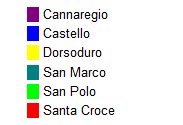
- -- Cannaregio
- -- San Polo
- -- Dorsoduro
- -- Santa Croce
- -- San Marco
- -- Castello
Islands of the Venetian Lagoon
- Murano -- Island of salt mines and the guild of glass-makers, the majority of the islands inhabitants are fishermen or farmers. {Independent township}
Storia
Introduzione
The Republic of Venice (Venetian: Repùblica Vèneta; Italian: Repubblica di Venezia), traditionally known as the Most Serene Republic of Venice (Venetian: Serenìsima Repùblica Vèneta; Italian: Serenissima Repubblica di Venezia), was a sovereign state and maritime republic in northeastern Italy, which existed for a millennium between the 8th century and the 18th century. It was based in the lagoon communities of the historically prosperous city of Venice, and was a leading European economic and trading power during the Middle Ages and the Renaissance.
Umili Origini
The history of the Republic of Venice traditionally begins with its foundation at noon on Friday 25 March AD 421, by authorities from Padua, to establish a trading-post in that region of northern Italy; the founding of the Venetian republic also was marked with the founding of the church of St. James. The early city of Venice existed as a collection of lagoon communities who united for mutual defense against the Lombards, as the power of the Byzantine Empire dwindled in northern Italy in the late 7th century.
Early in the 8th century, the people of the lagoon elected their first leader Orso Ipato (Ursus), who was confirmed by Byzantium with the titles of hypatus and dux. Historically, Ursus was the first Doge of Venice. Tradition, however, since the early 11th century, dictates that the Venetians first proclaimed one Paolo Lucio Anafesto (Anafestus Paulicius) duke in AD 697, although the tradition dates only from the chronicle of John, deacon of Venice (John the Deacon); nonetheless, the power base of the first doges was in Eraclea.
Population
- -- 120,000
Cemeteries
Fortifications
Holy Ground
Churches
Convents
Inns
Landmarks
- -- Palazzo Ducale (The Doge's Palace)
- -- Rialto Bridge
Law & Lawlessness
Monuments
Private Residences
- -- Casa di Giovanni -- The Mausoleum
Taverns
Visitors
- Talib Samara -- Moorish Pirate
Whore Houses
The Vampires of Venice
Cappadocians
- Goffredo Adimari -- A Cappadocian monk from
The Giovanni Bloodline
- Augustus Giovanni -- Third Generation Progenitor of the Giovanni Clan of Vampires
- Ambrogino Giovanni -- Giovanni Savant
- Ignazio Giovanni -- Scourge of Venice
Lasombra
- Narses -- Archbishop of Nod and Prince of Venice
- Guilelmo Aliprando -- Seneschal of Venice
Toreador
- Vasileios Michelakis -- Artisan of Glass
Tremere
- Ansovald -- Thaumaturgic tutor to Augustus Giovanni, resident of the Venetian Ghetto in the Sestieri Cannaregio.
Ventrue
- Eadwulf -- The Huntsman - {Saxon} - Now posing as the mortal Captain Marko of the Isle of Murano.
Websites
http://en.wikipedia.org/wiki/Venice
http://visualovation.typepad.com/theartofcarnivaleinvenice/2011/01/once-upon-a-mask-3.html {Golden Masks}

